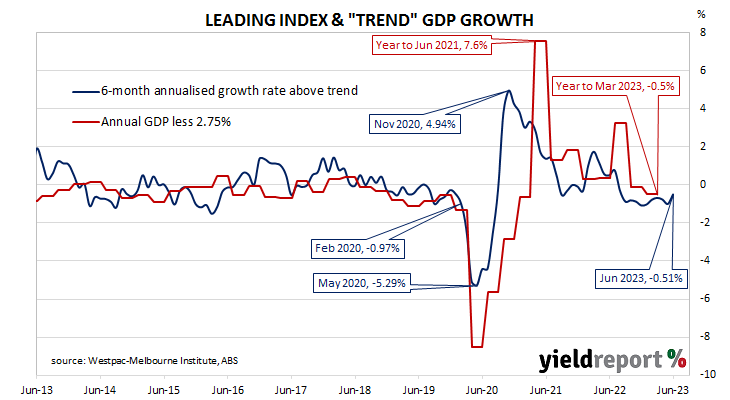Summary: Leading index growth rate rises in June; in negative territory for eleventh consecutive month; reading implies annual GDP growth of around 2.25%; ACGB yields fall noticeably; rate-rise expectations soften; US industrial production, dwelling approvals and yield curve main drivers.
Westpac and the Melbourne Institute describe their Leading Index as a composite measure which attempts to estimate the likely pace of Australian economic growth in the short-term. After reaching a peak in early 2018, the index trended lower through 2018 and 2019 before plunging to recessionary levels in the second quarter of 2020. Subsequent readings spiked towards the end of 2020 but then trended lower through 2021, 2022 and the first half of 2023.
The June reading of the six month annualised growth rate of the indicator registered -0.51%, up from May’s revised figure of -1.01%.
“Despite a welcome improvement in the growth rate of the Index in June it remains in negative territory for the eleventh consecutive month,” said Westpac Chief Economist Bill Evans.
Index figures represent rates relative to “trend” GDP growth, which is generally thought to be around 2.75% per annum in Australia. The index is said to lead GDP by “three to nine months into the future” but the highest correlation between the index and actual GDP figures occurs with a three-month lead. The current reading thus represents an annual GDP growth rate of around 2.25% in the next quarter.
Domestic Treasury bond yields fell noticeably on the day, outpacing the falls of US Treasury bonds yields overnight. By the close of business the 3-year ACGB yield had lost 9bps to 3.78%, the 10-year yield had shed 11bps to 3.86% while the 20-year yield finished 12bps lower at 4.15%.
In the cash futures market, expectations regarding further rate rises generally softened. At the end of the day, contracts implied the cash rate would rise from the current rate of 4.07% to average 4.16% in August and then to 4.205% in September. February 2024 contracts implied a 4.345% average cash rate while May 2024 contracts implied 4.32%, 25bps more than the current rate.
Evans noted most of the improvement over the month came from changes in US industrial production, dwelling approvals and the yield curve.


